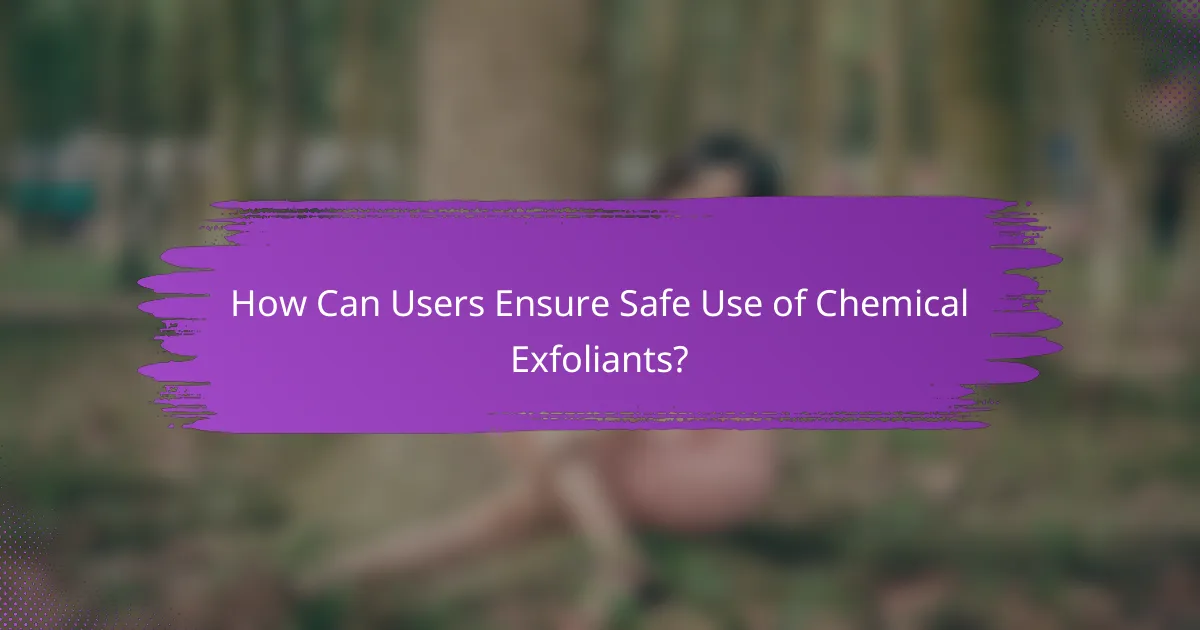Chemical exfoliants are skincare substances designed to remove dead skin cells through the use of acids or enzymes. This article explores the benefits, risks, and best practices for safely using chemical exfoliants, including alpha hydroxy acids (AHAs) like glycolic acid and beta hydroxy acids (BHAs) such as salicylic acid. Key guidelines for safe application include performing patch tests, selecting appropriate concentrations, and avoiding over-exfoliation. Additionally, the importance of daily sunscreen use and consulting a dermatologist for personalized advice is emphasized to ensure effective and safe skincare routines.

What are Chemical Exfoliants and How Do They Work?
Chemical exfoliants are substances used in skincare to remove dead skin cells. They work by utilizing acids or enzymes to dissolve the bonds between skin cells. Common types include alpha hydroxy acids (AHAs) and beta hydroxy acids (BHAs). AHAs, like glycolic acid, are water-soluble and effective for surface exfoliation. BHAs, such as salicylic acid, are oil-soluble and penetrate deeper into pores. This process promotes cell turnover and improves skin texture. Studies show that regular use can enhance skin radiance and reduce signs of aging. Proper application and concentration are crucial for safety and effectiveness.
What types of chemical exfoliants are commonly used?
Common types of chemical exfoliants include alpha hydroxy acids (AHAs) and beta hydroxy acids (BHAs). AHAs, such as glycolic acid and lactic acid, are water-soluble and primarily target the skin’s surface. They help in improving skin texture and reducing signs of aging. BHAs, like salicylic acid, are oil-soluble and penetrate deeper into pores. They are effective for acne-prone skin by helping to clear out excess oil and debris. Both AHAs and BHAs promote cell turnover and enhance skin radiance. The effectiveness of these exfoliants is supported by numerous dermatological studies, confirming their benefits for various skin types.
What are the differences between AHAs and BHAs?
AHAs (alpha hydroxy acids) and BHAs (beta hydroxy acids) are both chemical exfoliants used in skincare. AHAs are water-soluble and derived from fruits, primarily targeting the skin’s surface. They help improve skin texture and hydration. Common AHAs include glycolic and lactic acid.
In contrast, BHAs are oil-soluble and penetrate deeper into pores. They are effective for oily and acne-prone skin. Salicylic acid is the most common BHA. AHAs generally promote surface exfoliation, while BHAs address issues like clogged pores and acne.
Research indicates that AHAs are best for dry skin types, while BHAs are beneficial for oily skin. This distinction is crucial for selecting the appropriate exfoliant based on skin type and concerns.
How do enzymes function as exfoliants?
Enzymes function as exfoliants by breaking down the bonds between dead skin cells. This process promotes the removal of these cells from the skin’s surface. Enzymes such as papain from papaya and bromelain from pineapple are commonly used. They specifically target keratin, a protein in skin cells. This targeted action helps to gently exfoliate without harsh scrubbing. Studies show that enzyme exfoliation can improve skin texture and clarity. Additionally, enzyme exfoliants are often less irritating than mechanical or chemical exfoliants. This makes them suitable for sensitive skin types.
What benefits do chemical exfoliants provide for the skin?
Chemical exfoliants provide multiple benefits for the skin. They effectively remove dead skin cells, promoting cell turnover. This process enhances skin texture and radiance. Chemical exfoliants can also help unclog pores, reducing the risk of acne. They improve the absorption of skincare products by allowing deeper [censured]. Additionally, these exfoliants can diminish the appearance of fine lines and wrinkles. Studies show they can even out skin tone by fading hyperpigmentation. Overall, chemical exfoliants contribute to healthier and more youthful-looking skin.
How do chemical exfoliants improve skin texture?
Chemical exfoliants improve skin texture by removing dead skin cells from the surface. They contain active ingredients like alpha hydroxy acids (AHAs) and beta hydroxy acids (BHAs). AHAs, such as glycolic acid, enhance moisture content and promote cell turnover. BHAs, like salicylic acid, penetrate deeper into pores, reducing oiliness and preventing acne. This process leads to smoother, more radiant skin. Studies show that regular use of chemical exfoliants can diminish fine lines and uneven skin tone. For instance, a study published in the Journal of Dermatology found that AHAs significantly improved skin texture in participants after consistent use.
What role do chemical exfoliants play in acne treatment?
Chemical exfoliants play a significant role in acne treatment by removing dead skin cells and unclogging pores. This process helps to prevent the formation of acne lesions. Common chemical exfoliants include alpha hydroxy acids (AHAs) and beta hydroxy acids (BHAs). AHAs, like glycolic acid, are effective for surface exfoliation. BHAs, such as salicylic acid, penetrate deeper into the pores. Research shows that salicylic acid reduces acne lesions by 50% in some cases. Regular use of these exfoliants can lead to smoother skin and reduced breakouts.
What are the potential risks associated with chemical exfoliants?
Chemical exfoliants can pose several risks to the skin. These risks include irritation, redness, and sensitivity. Overuse can lead to skin barrier damage. This damage may result in increased dryness and peeling. Allergic reactions can also occur, causing swelling and hives. Some individuals may experience photosensitivity, increasing sunburn risk. Chemical burns are a rare but serious risk associated with improper use. Studies indicate that individuals with sensitive skin are at higher risk for adverse effects.
What side effects can users experience?
Users of chemical exfoliants can experience several side effects. Common side effects include redness and irritation of the skin. Users may also notice peeling or flaking as the skin adjusts. Some individuals experience dryness or tightness after application. Allergic reactions can occur, leading to hives or swelling. Sensitivity to sunlight may increase, requiring users to apply sunscreen. In rare cases, chemical burns can happen if the product is misused. These side effects are documented in dermatological studies, emphasizing the importance of patch testing and following usage guidelines.
How can skin sensitivity be affected by chemical exfoliants?
Chemical exfoliants can increase skin sensitivity. They work by removing dead skin cells, which can disrupt the skin barrier. This disruption may lead to increased redness, irritation, and a burning sensation. Certain acids, like alpha-hydroxy acids (AHAs) and beta-hydroxy acids (BHAs), are commonly used in chemical exfoliants. These acids can lower the skin’s pH, making it more reactive. Studies show that individuals with sensitive skin may experience heightened reactions to these products. Therefore, it is essential to patch test and introduce these exfoliants gradually.

How Can Users Ensure Safe Use of Chemical Exfoliants?
Users can ensure safe use of chemical exfoliants by following specific guidelines. First, they should perform a patch test before full application. This test helps identify potential allergic reactions, as 10% of users experience irritation from certain acids. Second, they must choose the appropriate concentration for their skin type. For instance, beginners should start with lower concentrations, such as 5-10% glycolic acid. Third, users should avoid combining multiple exfoliating products simultaneously to prevent over-exfoliation. Over-exfoliation can lead to skin barrier damage, resulting in redness and sensitivity. Additionally, applying sunscreen daily is crucial, as chemical exfoliants increase sun sensitivity. Research indicates that using SPF 30 or higher can reduce the risk of sunburn in sensitive skin. Lastly, consulting a dermatologist before starting a new exfoliation regimen is recommended. This professional guidance can tailor the approach to individual skin needs, ensuring safety and effectiveness.
What best practices should be followed when using chemical exfoliants?
When using chemical exfoliants, start with a patch test to check for skin sensitivity. This helps prevent adverse reactions. Use the product as directed, typically once or twice a week for optimal results. Gradually introduce the exfoliant into your routine to allow your skin to adjust. Always follow up with sunscreen, as chemical exfoliants can increase sun sensitivity. Avoid using multiple exfoliating products simultaneously to reduce the risk of irritation. It is essential to moisturize after exfoliation to maintain skin hydration. Consult a dermatologist if unsure about product suitability for your skin type.
How often should chemical exfoliants be applied for optimal results?
Chemical exfoliants should be applied 1 to 3 times per week for optimal results. This frequency allows the skin to benefit from exfoliation while minimizing irritation. Overuse can lead to sensitivity and compromised skin barrier. Studies suggest that starting with once a week is advisable for those new to chemical exfoliants. Gradually increasing frequency can be done based on individual skin tolerance. Research indicates that regular use can enhance skin texture and promote cell turnover. It’s essential to monitor skin response and adjust accordingly.
What precautions should be taken to avoid over-exfoliation?
Limit exfoliation to 1-3 times per week to prevent over-exfoliation. Choose exfoliants suited for your skin type. Monitor skin reactions after each use. Adjust frequency based on skin sensitivity and condition. Use gentle formulas to minimize irritation. Avoid combining multiple exfoliating products in the same routine. Hydrate and moisturize the skin post-exfoliation. Consult a dermatologist for personalized advice if unsure.
How can users identify the right chemical exfoliant for their skin type?
Users can identify the right chemical exfoliant for their skin type by assessing their skin concerns and type. Oily skin typically benefits from salicylic acid, which penetrates pores. Dry skin often responds better to glycolic acid, which hydrates while exfoliating. Sensitive skin may require lactic acid, known for its gentler properties. Users should also consider the concentration of the exfoliant. Lower concentrations are safer for beginners or sensitive skin. Patch testing is crucial to avoid adverse reactions. Consulting a dermatologist can provide personalized recommendations based on specific skin needs. These guidelines help users select the most suitable chemical exfoliant effectively.
What factors should be considered when choosing a chemical exfoliant?
Skin type is a crucial factor when choosing a chemical exfoliant. Different skin types react differently to various ingredients. For instance, sensitive skin may require gentler exfoliants like lactic acid. Oily skin types often benefit from stronger acids like salicylic acid. The concentration of active ingredients is also important. Higher concentrations can provide more effective exfoliation but may increase irritation. Additionally, the pH level of the product affects its efficacy. A lower pH typically enhances exfoliation but can also lead to irritation. The formulation of the exfoliant should be considered as well. Products with soothing ingredients can mitigate potential irritation. Lastly, the intended results matter; whether seeking to improve texture, reduce acne, or lighten pigmentation can guide the choice.
How can skin type influence the choice of exfoliant?
Skin type significantly influences the choice of exfoliant. Oily skin typically benefits from chemical exfoliants like salicylic acid. This ingredient helps to unclog pores and reduce excess oil. Dry skin, on the other hand, may require gentler options like lactic acid. Lactic acid hydrates while exfoliating, preventing further dryness. Sensitive skin should opt for mild exfoliants such as glycolic acid in lower concentrations. These options minimize irritation while still providing exfoliation. Combination skin may require a balanced approach, using different exfoliants on various areas. Ultimately, selecting the right exfoliant based on skin type ensures effective and safe results.

What Are Expert Recommendations for Chemical Exfoliant Use?
Experts recommend starting with lower concentrations of chemical exfoliants. This helps the skin adjust and minimizes irritation. Gradually increase the concentration based on skin tolerance. Using chemical exfoliants two to three times a week is often advised. Daily use may lead to over-exfoliation and skin sensitivity. Always apply sunscreen during the day after using exfoliants. Chemical exfoliants can increase sun sensitivity. Patch testing is recommended before full application. This helps identify any adverse reactions. Consulting a dermatologist is advisable for personalized guidance.
What tips do dermatologists provide for effective exfoliation?
Dermatologists recommend several tips for effective exfoliation. First, choose the right exfoliant for your skin type. Chemical exfoliants like AHAs and BHAs are effective for various skin concerns. Second, exfoliate no more than 2-3 times a week to avoid irritation. Over-exfoliating can lead to skin sensitivity and damage. Third, always apply sunscreen after exfoliating. Exfoliation can increase sun sensitivity. Fourth, follow up with a moisturizer to hydrate the skin. This helps maintain the skin barrier. Lastly, patch test new products before full application. This ensures no adverse reactions occur. These practices are supported by dermatological guidelines for maintaining skin health.
How can users incorporate chemical exfoliants into their skincare routine?
Users can incorporate chemical exfoliants into their skincare routine by starting with a low concentration product. This helps to assess skin tolerance. Gradually increase usage frequency, beginning with once a week. After skin adjusts, users can apply 2-3 times weekly. It is essential to follow up with sunscreen during the day. Chemical exfoliants can increase sun sensitivity. Users should apply the exfoliant on clean, dry skin. Allow the product to absorb before applying other skincare items. This method ensures effective exfoliation while minimizing irritation.
What signs indicate that a chemical exfoliant is working effectively?
Signs that a chemical exfoliant is working effectively include improved skin texture and a brighter complexion. Users may notice a reduction in dullness and uneven skin tone. Additionally, mild tingling or slight redness can indicate active ingredients at work. These sensations should be temporary and not severe. Enhanced skin smoothness and a reduction in the appearance of fine lines may also occur. Visible sloughing of dead skin cells is another sign of effectiveness. Users should monitor for these changes over several weeks for best results.
What common mistakes should be avoided when using chemical exfoliants?
Common mistakes to avoid when using chemical exfoliants include over-exfoliation, not following product instructions, and neglecting sunscreen application. Over-exfoliation can lead to skin irritation and barrier damage. Users should adhere to recommended usage frequency to maintain skin health. Not patch testing new products may result in adverse reactions. Additionally, skipping sunscreen can increase the risk of sun damage after exfoliation. Proper hydration post-exfoliation is also essential for skin recovery.
How can users prevent irritation and adverse reactions?
Users can prevent irritation and adverse reactions by conducting a patch test before using chemical exfoliants. This involves applying a small amount of the product to a discreet skin area and monitoring for any adverse effects. Gradually introducing the product into their skincare routine can also help. Users should start with a lower concentration and increase as their skin builds tolerance. Hydrating the skin before and after application minimizes dryness and irritation. Additionally, following product instructions carefully ensures proper usage. It is also essential to avoid combining multiple exfoliating agents to prevent over-exfoliation. Research indicates that these practices significantly reduce the likelihood of adverse reactions while maximizing benefits.
What should users do if they experience negative side effects?
Users should immediately discontinue the use of the chemical exfoliant if they experience negative side effects. This action helps prevent further irritation or damage to the skin. Next, they should gently cleanse the affected area with a mild soap and lukewarm water. Avoid using harsh products that could exacerbate the situation. Users may apply a soothing moisturizer to alleviate discomfort. If symptoms persist or worsen, consulting a healthcare professional is advisable. Documenting the specific side effects can assist the professional in providing accurate advice. Immediate attention to adverse reactions is crucial for skin health.
Chemical exfoliants are substances used in skincare to remove dead skin cells, primarily through alpha hydroxy acids (AHAs) and beta hydroxy acids (BHAs). This article explores the benefits of chemical exfoliants, including improved skin texture, enhanced radiance, and acne treatment, while also addressing potential risks such as irritation and over-exfoliation. Key best practices for safe use are outlined, including the importance of patch testing, appropriate concentration selection, and the need for sun protection. Additionally, the article provides expert recommendations on incorporating chemical exfoliants into skincare routines effectively.


